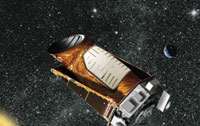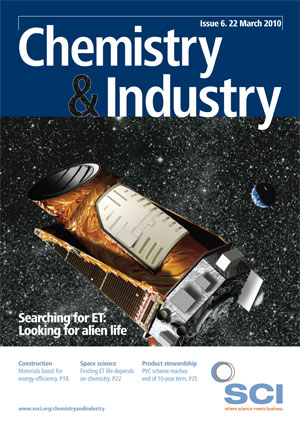Discoveries of numerous extrasolar planets have boosted the hope of finding life elsewhere, with a little help from chemistry. Michael Gross investigates
Only 15 years ago, Michel Mayor and Didier Queloz obtained the first solid evidence of a planet orbiting a star that wasn’t our Sun, using the Doppler effect to detect the planet’s pull on its star. Only ten years ago, researchers observed for the first time the minute loss of brightness when such an extrasolar planet passes through our sightline – an event called a ‘transit’.
Since then, the discovery of hundreds of other extrasolar planets has dramatically changed the way in which we can look at the age-old question of whether we are alone in the Universe. What used to be a question of statistics, philosophy and speculation can now be addressed with the tools of chemistry, as transit events allow researchers, in principle, to analyse the atmospheres of transiting exoplanets spectroscopically and to look for chemical signatures of life.
Planet hunters
Many of the 429 exoplanets discovered so far, especially those detected by the Doppler effect, are Jupiter-sized objects on Mercury-style orbits, thus presumably too hot and too heavy to support life. Astronomers are, however, increasingly successful in the hunt for smaller, more Earth-like planets in less punishing locations. A key tool in the analysis of distant Earth-like worlds is the CoRoT probe – short for Convection, Rotation, and Transit –which not only looks for transit events, but also investigates density fluctuations within the stars caused by the pull of orbiting planets with a method known as stellar seismology.
Malcolm Fridlund, a Swedish astronomer working for the European Space Agency in the Netherlands, says, ‘the challenge is equivalent to finding a firefly next to a lighthouse, but from 10,000km away’. And yet the probe has risen to the challenge; so far, it has discovered and studied more than 20 of those fireflies.
One of the most interesting is CoRoT 7B, a planet only 1.58 larger in diameter and 4.8 times heavier than our own, orbiting a sun-like star.1,2 The bad news is that this planet is almost scratching the star’s surface, orbiting at a height of only five star radii, which means the its surface temperature must be around 2000ºC.
The CoRoT mission is already getting competition from other planet-hunting space probes. NASA’s Kepler mission, which started in May 2009, reported its first five exoplanets in January, based on data collected in the first six weeks of operation. Kepler is designed to detect Earth-like planets in the habitable zones of their systems. It will investigate 100,000 stars during its 3.5 year mission.
And even from the ground one can observe and characterise exoplanets, as recent research shows. In December 2009, David Charbonneau at Harvard University and colleagues in several countries reported the discovery of a ‘super-Earth’ transiting a nearby, low-mass star.3 The planet GJ1214b has a mass of 6.55 Earth masses and a much lower density, suggesting that it must contain large amounts of water. They made the discovery with an array of eight modest amateur-sized telescopes, with mirrors only 40cm in diameter.
Once a transiting exoplanet has been discovered, researchers can try to scrutinise the changes to the light spectrum of the star during the transit, that is they essentially record a difference spectrum that should reveal the spectroscopic properties of the passing planet. Applying this approach and using the Hubble and Spitzer space telescopes, researchers have been able to detect water, methane, carbon dioxide, and carbon monoxide in the atmospheres of Jupiter-sized exoplanets HD 189733b and HD 209458b
And the absorption of light is not the only way astronomers can detect molecules in the atmospheres of distant planets. In February 2010, Mark Swain from the Jet Propulsion Laboratory at Pasadena, California, with an international team of colleagues reported the detection of fluorescence emission of methane molecules from HD 189733b using ground-based telescopes.4
How can we tell if a distant planet may support life? ‘Look at Earth as a simple model,’ Fridlund says, ‘move it ten parsecs away – what would we be able to see?’ (A parsec is 3.26 light years.) In chemical terms, the most telling trace of life detectable at such distances would be disequilibrium. For instance, the Earth’s atmosphere contains both methane and oxygen, which is a thermodynamically unstable situation, so methane – the less abundant reagent – must be replenished by some processes, which could be geological, but could well be – as in our case - biological.
As the number of known exoplanets is still growing rapidly, and methods to study them more efficiently are still being developed, the exploration of faraway worlds is only just beginning, but chemistry will have an important role in it.
A second genesis

To find this elusive ‘second genesis’, astrobiologists are prepared to look wherever there may be a chance of finding something that is or once was alive. Within our own solar system, Mars is still the prime candidate, in spite of the failure of previous missions to find traces of life.
Recent results from the lander Phoenix, which set down in the northern polar region in May 2008, have strengthened the evidence that Mars has had liquid water until very recently in geological timescales. Only 5m years ago, the polar region, which was then at much lower latitude, may have carried liquid water. One indication of this is the occurrence of segregated ice that has repeatedly thawed and refrozen, thereby expelling dust and impurities.
Phoenix also discovered perchlorate (ClO4–) ions at a baffling concentration of 1%.5 According to McKay, this finding undermines the analytical techniques by which Phoenix was supposed to look for organic molecules as heating organics in presence of perchlorate would destroy them before they can reach the detector. If this perchlorate content is a general feature of Martian soil, it would also invalidate the results returned by the Viking probes in the 1970s, which were interpreted as negative.
Colin Pillinger, who in 2003 became the televised face of the lost Beagle 2 mission, agrees that the case for life on Mars is wide open again. For the doomed mission, he had developed an alternative, isotope based method to detect organic molecules on Mars which, as he says, ‘can find every carbon atom in whatever form,’ using a combination of gas chromatography and mass spectrometry.
While Mars has attracted most of the attention of life-seekers, some of the moons of Saturn and Jupiter also offer potential habitats for simple life forms. Jupiter’s moon Europa, and Saturn’s Titan have long been touted as possible hosts of weird life forms or at least interesting prebiotic chemistry in Europa’s subsurface oceans and Titan’s hydrocarbon lakes. During the ongoing Cassini mission, which has recently won a second extension through to 2017, Saturn’s moon Enceladus has emerged as another prime location for unusual life forms. Cassini detected jets of water rising from Enceladus. All the requirements concerning elements (C, H, O, N) and the energy disequilibrium considered essential for life are met on Enceladus, says McKay.
The biggest challenge may be to recognise life when we see it. ‘If it’s like us, it will be easy to recognise but not very interesting,’ says McKay. ‘If it’s very alien, it will be interesting but extremely hard to spot.’ One key characteristic, he suggests, will be the distribution of organic molecules. Any living system will use and produce certain organic molecules but not others, leading to a highly discontinuous spectrum of molecular properties. An abiotically produced mixture of hydrocarbons, by contrast, should display a continuous distribution covering all molecules accessible under the reaction conditions to some extent.
Paul Davies, the widely known physicist and popular science writer, has recently secured research funding to find a ‘second genesis’ in an even more exotic location – our own planet. Most scientists assume that our form of life – although it may not have been the only one present in the early days of our planet – was so successful that it steamrollered – or ate – everything else. The universality of features like the genetic code and the protein synthesis machinery suggests that our be a ‘shadow biosphere’ hidden within or next to our own biosphere. As the vast majority of microorganisms on our planet have not yet been cultivated and are therefore uncharacterised, Davies argues, there may well be some operating on completely different molecular systems. As all our detection methods are looking for the kind of life we know already, we may well have missed something that is different.
Davies has started to look for such shadow life in environments defined by extreme physical or chemical conditions, for example the presence of high concentrations of arsenate, which could take over the role that phosphate plays in our cells.
What if ET calls?
While hopes of finding some kind of microbial life somewhere in the Universe have received a boost from the planet discoveries and recent explorations of our own planetary system, the search for extraterrestrial intelligence (SETI), started by Frank Drake just over 50 years ago, and popularised by Carl Sagan, is still drawing blanks.
Drake is still pursuing this line of research at SETI in California and was celebrated at a recent meeting of the Royal Society on ‘the detection of extraterrestrial life and its consequences for science and society’. He is optimistic that other civilisations are ‘out there’ and that modern technology, with listening devices now 1014 times more powerful than the radio receiver with which he started 50 years ago, will eventually pick up some kind of signal from them. However, he admits that with the progress in communications technology, Earth’s radio wave emissions into space have decreased significantly, so other civilisations may be more difficult to spot.
But what if we do find life, not just microbes but advanced life forms like those featured in science fiction series from Star Trek to Battlestar Galactica? Palaeontologist Simon Conway Morris at the University of Cambridge, UK, based on his studies of evolution here on Earth, thinks that similar constraints may have led to the evolution of similar traits even in completely unrelated life forms. Convergent evolution has produced camera eyes many times independently, so extraterrestrials may also have eyes similar to ours, even if their molecular biology is unrelated.
Conway Morris thinks that this may also apply to behaviour, and that other planets may also have produced an intelligent species that aggressively expands into any new territory that it finds. Therefore his recommendation to those who look for extraterrestrial intelligence is: ‘If ET calls, don’t pick up that phone!’
Michael Gross is a science writer based in Oxford, UK.
References
1.A. Léger et al., Astron. Astrophys., 2009, 506, 287.
2. D. Queloz et al., Astron. Astrophys., 2009, 506, 303.
3. D. Charbonneau et al., Nature, 2009, 462, 891.
4. M.R.Swain et al., Nature, 2010, 463, 637.
5. M. Hecht et al., Science, 2009, 325. 64.





